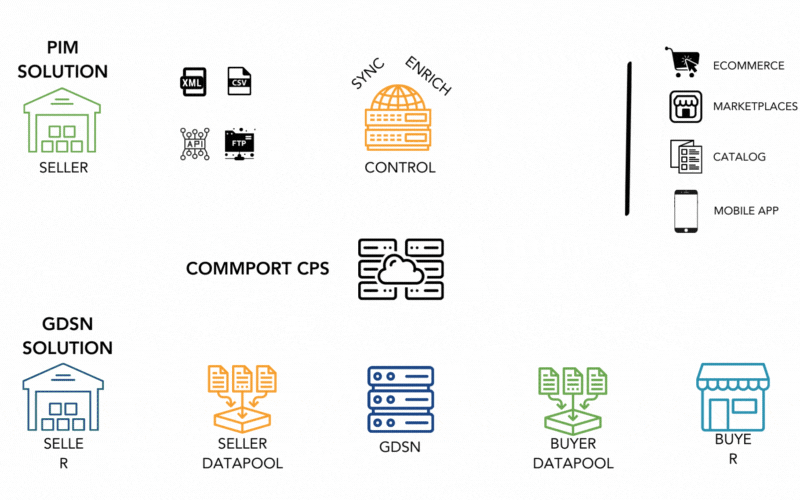Introduction
Today’s consumers are bombarded with information from every direction, and having high-quality product content is essential for standing out from the competition.
But how do you ensure that your brand’s message reaches a wider audience and increases visibility?
The answer lies in product content syndication.
Product content syndication is a strategic approach that enables brands to share their product information across multiple platforms, reaching a broader audience and driving increased brand awareness. By syndicating your product content, you can unlock the power of cross-channel promotion and tap into new customer segments you may have previously overlooked.
It ensures that your product data is efficiently distributed to various platforms, enabling a seamless and unified shopping experience for customers. It’s your first step towards providing an omnichannel experience for your customers.
But what exactly is product content syndication, and why is it vital for modern businesses?
Key Takeaways
- Product Content Syndication is the process of sharing product information across multiple sales and marketing channels.
- It ensures consistent, accurate, and up-to-date product details on platforms like retailer websites, marketplaces, and e-commerce sites.
- Effective syndication enhances brand visibility, customer trust, and sales by delivering quality content where customers shop.
- It simplifies managing product information across channels, reducing the risk of data inconsistencies.
- Automating content syndication can save time, reduce errors, and improve the customer experience.
What is Product Content Syndication?

Product Content Syndication refers to the systematic distribution of product information—such as images, descriptions, prices, and specifications—across multiple digital platforms like e-commerce sites, third-party marketplaces, and retail partners.
Syndication ensures that all the platforms where your product is listed feature accurate, standardized, and updated product data. This consistency is essential for maintaining brand integrity and meeting the expectations of both retailers and customers.
The Group of Analysts (TGOA) releases a new research report that sheds light on the current product content syndication market.
What is the Difference Between Product Content Syndication and Product Data Syndication?

While Product Content Syndication focuses on the marketing side of the product—images, descriptions, and features that help sell the product—Product Data Syndication dives into the technical details, ensuring that all product attributes, dimensions, and specifications are correctly represented. Product data syndication involves the integration of backend systems to maintain data integrity across channels, while product content syndication enhances how the product appears to consumers online
Product content syndication is about presentation and promotion, while product data syndication is about accuracy and consistency.
Empower Your Digital Channels with Product Content Automation
Product content syndication automates the process of distributing product information, ensuring that online retailers, distributors, and marketplaces receive up-to-date and high-quality content. This not only enhances the visibility of products but also boosts their chances of being purchased as consumers are provided with clear, relevant, and consistent information, no matter where they shop.
Automation in product content distribution eliminates manual errors, saves time, and ensures scalability as your business grows. With automated syndication solutions, businesses can efficiently manage content updates and streamline the syndication process.
The Importance of Product Content Syndication for Brand Visibility
In a marketplace saturated with information, product content syndication emerges as a vital strategy for enhancing brand visibility. Businesses today face the challenge of capturing consumer attention amidst a sea of competitors. By leveraging syndication, brands can ensure that their product information is disseminated across multiple channels, enhancing the likelihood of reaching potential customers who may not encounter them otherwise. This cross-channel presence not only increases brand awareness but also builds credibility as consumers begin to see consistent messaging across various platforms.
Product syndication allows brands to tap into niche markets and demographics. By sharing content on platforms that cater to specific audiences, companies can engage with potential customers who might be more interested in their products. This targeted approach not only maximizes the relevance of the message but also fosters a more meaningful connection with consumers, paving the way for brand loyalty and repeat business.
What Data Will You Find in a Product Feed?
A typical product feed used for syndication contains several essential data elements, including:
- Product Titles and Descriptions: Clear, optimized titles and engaging descriptions that highlight product benefits.
- Images and Videos: High-quality visuals that enhance the product’s appeal.
- Pricing Information: Updated prices, discounts, and promotions.
- Technical Specifications: Key product attributes like dimensions, materials, and compatibility.
- Stock Availability: Real-time inventory data to avoid customer disappointment from out-of-stock products.
- Identifiers: Product identifiers such as SKU, GTIN, or UPC, which help standardize product listings across platforms.
What are the Benefits of Product Content Syndication?
Effective product content syndication offers a range of benefits, including:
- Increased Sales: Better product visibility across multiple platforms leads to higher conversion rates.
- Brand Consistency: Maintaining uniform product information enhances brand integrity and trust.
- Improved Time Efficiency: Automation reduces manual processes, allowing for quicker updates and expansion.
- Enhanced Customer Experience: Providing detailed and consistent product information improves the shopping experience, leading to higher customer satisfaction and loyalty.
- Reduced Errors: Automated syndication minimizes the risk of errors from manual data entry.
Why is Product Content Syndication Essential for Modern Digital Commerce?

As more businesses shift to digital channels, the need for accurate and engaging product content becomes even more critical. Product content syndication helps businesses reach new markets, diversify sales channels, and maintain a strong presence on high-traffic platforms like Amazon, eBay, and Google Shopping. Without an effective syndication strategy, brands risk losing out on potential sales, damaging their reputation with inconsistent information, and creating friction in the customer journey.
When to Invest in Product Content Syndication Solutions?
Businesses should consider investing in product content syndication solutions when they:
Expand to multiple sales channels: Whether it’s a new e-commerce platform or a retail partner, maintaining consistency across platforms becomes challenging without automation.
Experience rapid product updates: Companies with constantly changing product ranges, prices, or promotions need a scalable solution to keep up with updates.
Aim to streamline operations: Automating content distribution reduces manual efforts and eliminates the risk of outdated information being displayed on partner sites.
How Datapool Solutions Like GDSN and PIM Help with Product Content Syndication?
Datapool solutions such as GDSN (Global Data Synchronization Network) and PIM (Product Information Management) systems play a vital role in ensuring smooth product content syndication.
GDSN ensures that all product data is standardized and synchronized globally across all systems and partners. This helps businesses achieve global consistency and compliance with industry standards, enhancing the credibility and reach of their product information
Meanwhile, PIM systems centralize product data management, enabling businesses to gather, enrich, and distribute product information effortlessly. PIM solutions allow companies to maintain high data quality and easily push updates to multiple platforms in real time, thus improving the efficiency of product content syndication.
How to Choose the Best Product Content Syndication Solution?
Choosing the right product syndication solution depends on several factors:
- Scalability: Ensure the solution can scale with your business and accommodate future growth in channels and product offerings.
- Customization Options: Look for solutions that allow flexibility in managing content specific to different platforms and partners.
- Integration Capabilities: Ensure the solution can integrate with existing systems such as your ERP, CMS, or PIM.
- Support for Global Standards: Solutions like GDSN-compliant datapools help maintain global standardization, making them essential for businesses targeting international markets.
- Analytics and Reporting: opt for a solution that provides detailed analytics to measure the performance of your product listings and make data-driven improvements
Common Challenges and How to Overcome Them in Product Content Syndication
While product syndication offers numerous benefits, it also comes with its own set of challenges. One common issue is maintaining consistent and accurate product information across multiple platforms. As products evolve and updates are made, brands must ensure that all syndicated content reflects these changes. Failure to do so can lead to customer dissatisfaction and damage to brand credibility.
To overcome this challenge, brands should establish a robust product management system like a PIM / GDSN or both that allows for real-time updates. By centralizing product information, brands can ensure that any changes are automatically reflected across all syndication channels. This proactive approach minimizes the risk of outdated or inaccurate content being displayed to potential customers.
Another challenge is navigating the complexities of different syndication platforms. Each platform may have its own set of requirements and guidelines for content submission, which can be overwhelming. Brands can mitigate this issue by conducting thorough research on each platform’s specifications and creating standardized templates for their content. This streamlined process can save time and ensure that all submissions meet the necessary criteria.
Conclusion
Product content syndication is an essential strategy for businesses looking to thrive in the modern digital commerce ecosystem. By automating the distribution of accurate, engaging, and consistent product information across multiple channels, businesses can drive more sales, build brand trust, and create a seamless shopping experience. Investing in the right content syndication solution, especially one that integrates with datapools like GDSN and PIM systems, is crucial for achieving global consistency and operational efficiency.
Commport Product Syndication Solution
Download: GDSN Buyers Guide
Empower your business with global data synchronization; download our GDSN Buyer's Guide today and take the first step towards streamlined, accurate, and compliant product data management.
Frequently Asked Questions
Any business with multiple sales channels, such as manufacturers, brands, or retailers selling products through e-commerce platforms, marketplaces, and retail partners, can benefit from product syndication. It is particularly useful for businesses looking to maintain brand consistency and improve their market reach.
GDSN (Global Data Synchronization Network) and PIM (Product Information Management) systems ensure that product data is consistently updated, standardized, and synchronized across all platforms. GDSN helps achieve global compliance and consistency, while PIM centralizes data management and makes product syndication more efficient by pushing updates in real-time.
When choosing a product content syndication solution, consider factors like scalability, integration with your existing systems (ERP, PIM), support for global standards like GDSN, customization options for different platforms, and robust analytics to monitor performance and optimize strategies.
It ensures that consumers see consistent and accurate product information, regardless of where they shop. This reduces confusion, improves transparency, and makes purchasing decisions easier, ultimately leading to a better customer experience and increased loyalty.
Yes, It can be automated using specialized software or platforms. Automation eliminates manual data entry, reduces errors, and ensures faster updates across multiple sales channels. This saves time and allows businesses to scale their operations more efficiently.





